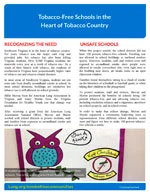Recognizing the Need
Southwest Virginia is in the heart of tobacco country. For years, tobacco was the major cash crop and provided jobs, but tobacco has also been killing Virginia residents. Over 9,200 Virginia residents die statewide every year as a result of tobacco use.1 As a result of their history with tobacco, the residents of southwestern Virginia have proportionally higher rates of tobacco use and tobacco-related diseases.
In most areas of Southwest Virginia, students are not even safe from deadly secondhand smoke at school. In most school divisions, buildings are smokefree but tobacco use is still allowed on school grounds.
Billie Murray from the American Lung Association in Virginia and Jenny Martin from the Virginia Foundation for Healthy Youth saw that change was needed.
After receiving a grant from the American Lung Association National Office, Murray and Martin worked with school districts to protect students, staff and families from exposure to secondhand smoke and tobacco use at school.
Unsafe Schools
When this project started, the school districts did not have 100 percent tobacco-free schools. Smoking was not allowed in school buildings or enclosed outdoor spaces. However, students, staff and visitors were still exposed to secondhand smoke since people were allowed to smoke everywhere else, even right next to the building near doors, air intake vents or an open classroom window.
Families found themselves sitting in a cloud of smoke on the bleachers of a football or baseball game, or when taking their children to the playground.
To protect students, staff and visitors, Murray and Martin promoted the benefits of schools being 100 percent tobacco-free and not allowing tobacco use, including smokeless tobacco and e-cigarettes, anywhere on school property, and at school events.
In order to make that culture change, Murray and Martin organized a community leadership team so representatives from different school districts could meet and figure out how to make 100 percent tobacco-free schools a reality.
Building the Team
The community leadership team recruited members serving many roles within their school system - superintendents, teachers, bus drivers, principals and nurses. The range of viewpoints helped the team consider all the potential issues with making this change and how best to overcome them.
Murray believes the most important members of the team were the students. While initially shy amongst a group of school officials, Murray says they opened up over the course of the project.
The students knew where their peers were sneaking off to smoke, which helped the team know where to place signage and where to concentrate enforcement efforts after the school became tobacco-free.
Murray also made sure the school divisions were not too far apart. School divisions in Southwest Virginia are often spread out so Murray made sure the selected school divisions were near each other and no one had to drive more than half an hour for a meeting.
Changing Norms, Spreading Awareness
Thanks to the efforts of the leadership team, four school divisions made the transition to 100 percent tobacco-free schools – Norton City and Wise, Dickenson and Russell Counties. Russell County’s effort was particularly challenging as Superintendent Brenda Hess initially had little support from her school board.
"Brenda Hess went in front of the board multiple times until she convinced them that this was important and the right thing to do," said Murray.
Once school districts decided to become 100 percent tobacco-free, efforts shifted to making sure people knew about the change and what it meant. Press events led to local news coverage and the project provided signs that openly and clearly stated the new policy.
While school boards are often concerned about complaints and policy violations, staff in the four divisions have been surprised by the popularity of the change and how smoothly students, staff and visitors have adapted to tobacco-free environments.
Continued Momentum
Murray is proud of the legacy of this project.
"Only 29 divisions in the entire state are 100 percent tobacco-free. Four of those are because of this project. Five more because of a previous project. That’s nine of 29 that are a direct result of this work in Southwest Virginia," said Murray.
Progress has continued after the grant and two nearby school districts in southwest Virginia have become 100 percent tobacco-free based on their neighbors’ examples. Additional school boards are also discussing making this change. Although the project itself may be over, the conversation about tobacco use in southwest Virginia schools has been permanently changed.
-
http://www.cdc.gov/tobacco/data_statistics/state_data/state_highli ghts/2010/pdfs/states/virginia.pdf
Page last updated: September 10, 2024


